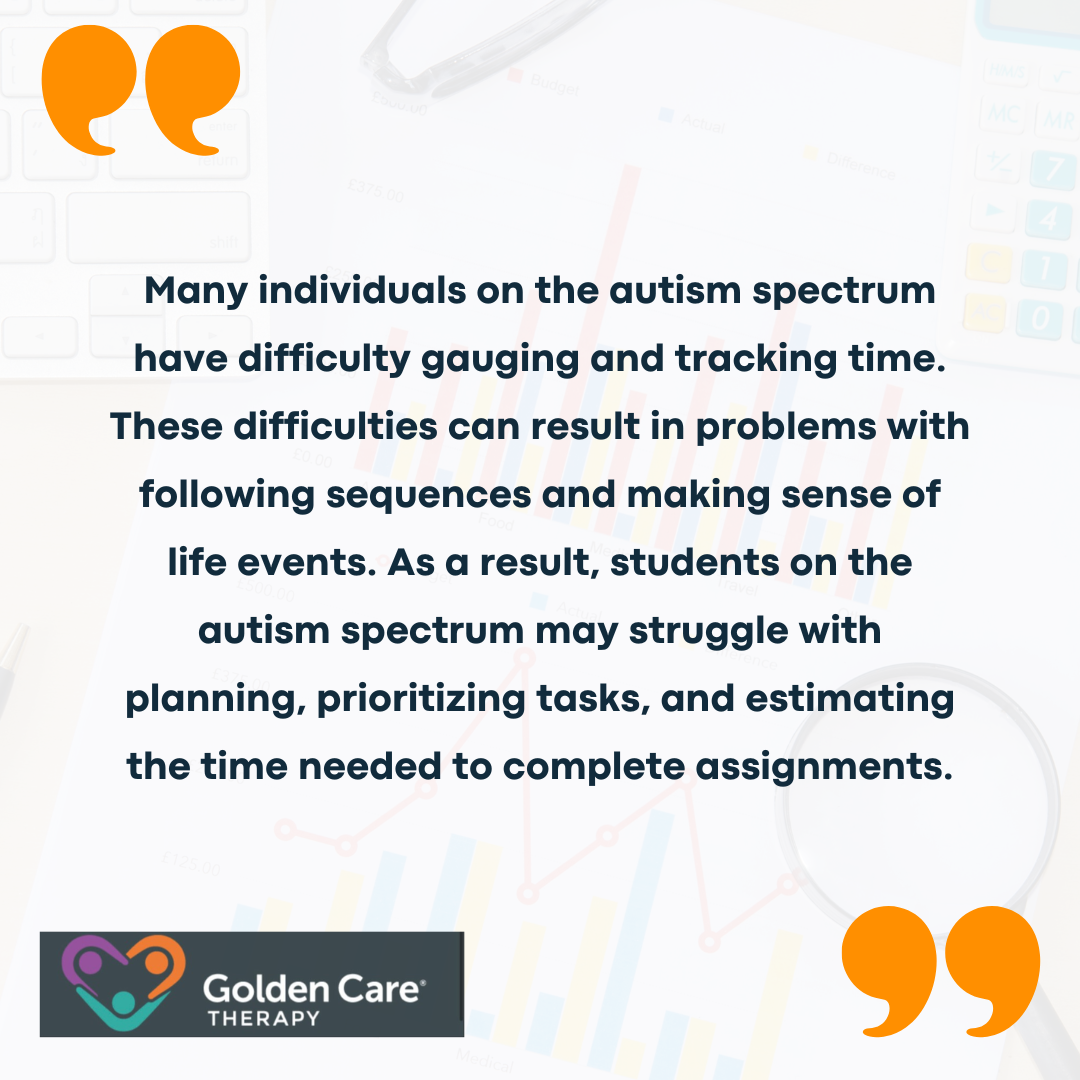Teaching time management to autistic adults can make a big difference in their daily lives. Time management helps people stay organized, reduce stress, and complete tasks more efficiently.
For autistic adults, learning to manage time might feel challenging due to differences in processing information or dealing with unexpected changes. However, with the right support and tools, time management skills can be developed and adapted to fit their individual needs.
In this guide, we’ll explore ways to help autistic adults build these skills in a clear, practical, and supportive manner.
Challenges with Time Perception
Many individuals on the autism spectrum struggle with gauging and tracking time. Concepts like “tomorrow” or “last week” may be challenging to grasp, and individuals may have difficulty estimating the time required to complete tasks accurately.
This difficulty in perceiving time can result in problems with following sequences and making sense of life events.
For individuals with autism, the passage of time may feel different, leading to a distorted perception of time. This can result in challenges in managing schedules, meeting deadlines, and planning day-to-day activities.
It is important to recognize and address these challenges to support individuals with autism in effectively managing their time.
To assist individuals with autism in managing time perception challenges, various strategies and tools can be employed. Visual timers, such as the Time Timer, can be particularly beneficial. These timers provide a visual representation of the passage of time, offering a clear visual countdown of the time remaining for a task.
This can help reduce stress and anxiety associated with time management, supporting planning skills needed to arrive at work or appointments on time.
Additionally, visual supports and time blocking can be useful tools for individuals with autism to manage their schedules effectively. Visual schedules provide a clear visual representation of daily activities and transitions, helping individuals understand and anticipate what comes next.
Time blocking involves dividing the day into specific time intervals for different activities, providing structure and organization to the day.
Effective Time Management Strategies
Autistic individuals may face unique challenges when managing their time effectively. However, there are certain strategies that can help them manage their time more efficiently and even reduce stress in the process.
In this section, we will explore three effective strategies to achieve those. These are as follows:
Task Chunking
Task chunking involves breaking down larger tasks into smaller, more manageable parts. This strategy is particularly helpful for individuals with autism who may struggle with sequencing and organization.
Breaking tasks into smaller steps allows for a clearer understanding of what needs to be done and helps prevent overload.
By dividing tasks into manageable chunks, individuals with autism can focus on completing one step at a time, leading to a sense of accomplishment and progress. This approach also helps in maintaining attention and concentration, as it eliminates the need to juggle multiple complex tasks simultaneously.

Creating Schedules
Creating schedules provides structure and predictability, which can greatly benefit individuals with autism. A visual schedule, in particular, can be an effective tool for managing time and reducing anxiety.
Visual schedules use visual cues, such as pictures or symbols, to represent tasks or activities in a sequential order.
Visual schedules help individuals with autism understand the expectations for the day, anticipate transitions, and stay on track. They provide a clear visual representation of the schedule, making it easier to comprehend and follow.
Following a schedule lets individuals with autism better manage their time and reduce the likelihood of becoming overwhelmed or disoriented.
Time Management in Education and Work
Time management is a crucial skill for success in education and the workplace. However, individuals on the autism spectrum may face unique challenges when it comes to managing time effectively.

Managing multiple demands on their time, such as school work, chores, extracurricular activities, and social pressures, can be overwhelming for students with autism. This can manifest in meltdowns, tantrums, and procrastination.
Establishing clear routines, breaking tasks into manageable chunks, and providing visual schedules can help students navigate these challenges and effectively manage their time.
Time Management in the Workplace
Time management issues can also arise for individuals with autism in the workplace. Some individuals may operate on a loose schedule, struggling to prioritize tasks and meet deadlines.
On the other hand, others may adhere very rigidly to a schedule, sometimes managing it minute to minute. These differences in time perception and management can impact productivity and collaboration in a work setting.
To support autistic individuals in the workplace, it is important to provide clear expectations and structure. This can be achieved through visual schedules, task lists, and regular communication about deadlines and priorities.
Employers can also consider providing accommodations such as flexible work hours or breaks to help individuals manage their time effectively.
Utilizing assistive tools and technologies can be beneficial for individuals with autism in both educational and work settings. Cell phones, iPads, calendars, and scheduling apps can provide visual cues and reminders to help individuals stay organized and on track.
These tools can be customized to suit the individual’s preferences and support their unique time management needs.
Tools for Time Management
Managing time effectively is crucial for individuals with autism as it helps them navigate daily routines and tasks. Fortunately, there are various tools available that can assist in improving time management skills.
Here are three useful tools that parents and caregivers should consider:

Visual Timers
Visual timers, such as the Time Timer, are valuable resources for individuals with autism, ADHD, and learning disorders. These timers provide a visual representation of the passage of time, making it easier to understand and manage time effectively.
One of the key benefits of visual timers is stress reduction. For individuals with autism, the concept of time can be abstract and challenging to grasp. Visual timers help alleviate this stress by providing a clear visual representation of time passing.
This can be particularly useful in managing everyday tasks and goals, supporting planning skills needed to arrive at work or appointments on time.
Visual timers also assist in breaking up complex tasks into manageable steps. By establishing realistic time frames for each step, individuals with autism can better understand and follow a structured approach. This breakdown of tasks promotes better time management and helps individuals stay organized throughout their routines.
Visual Schedules
Visual schedules are another effective tool for individuals with autism and other developmental challenges in managing schedule expectations and transitions throughout the day.
A visual schedule presents tasks and activities in a visual format, allowing individuals to easily comprehend and anticipate what comes next.
Visual schedules provide a sense of structure and predictability, which can be comforting for individuals with autism. By visually displaying the sequence of activities, visual schedules help individuals understand the order of tasks and reduce anxiety related to transitions.
These schedules can be created with pictures, symbols, or written words based on the individual’s preferences. They can be displayed on a wall, in a notebook, or on a digital device for easy reference.
Time Blocking
Time blocking is a technique where you divide the day into specific blocks of time dedicated to different activities or tasks. This approach can be particularly beneficial for individuals with autism as it provides a clear visual representation of how time is allocated throughout the day.
By assigning specific time blocks to different activities, individuals with autism can prioritize tasks and better manage their time. Time blocking helps create a structured routine and ensures that important tasks are not overlooked or delayed.
To implement time blocking effectively, individuals can use visual tools such as calendars, planners, or digital apps. These tools allow for easy visualization of the day’s schedule and help individuals stay on track with their planned activities.

The Bottom Line
In the end, teaching time management to autistic adults is about finding what works best for each individual. With patience, practice, and the right tools, managing time can become less stressful and more empowering. It’s all about creating a system that makes sense to them, allowing them to take control of their day and live more independently.
Every small step is progress, and with the right support, they can build confidence in their ability to manage their time successfully. For personalized care and guidance, consider Golden Care Therapy. If you’re seeking an ABA center in Indiana, New Jersey, New York, and Georgia, Golden Care Therapy is here to help.
Contact us today to learn more about how we can support you or your loved one.



